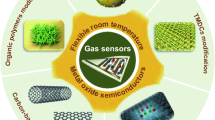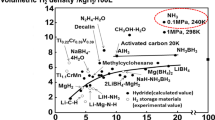Abstract
This work reports the growth of magnesium oxide (MgO) nanocubes by thermal chemical vapor deposition at various temperatures. The MgO nanocubes were investigated by X-ray diffraction, FESEM, EDAX, TEM and FTIR studies to study its various properties. The material is well-dispersed and has a cubical shape with an average size of 16 nm. XRD shows a face cubic centered structure, and SEM and TEM reveal nanocube morphology. The mechanism of the growth process is briefly detailed. The MgO nanocubes, if deposited on an overhead projector sheet, can be used as a chemoresistive sensor for hydrogen at a constant temperature of typically 200 °C and an applied voltage of 5 V. The sensor can detect hydrogen in the 3000 to 5000 ppm concentration range, and the lowest detectable concentration (at a signal-to-noise ratio of 3) is 3000 ppm.

Magnesium oxide (MgO) nanocubes were prepared using chemical vapor deposition technique on an alumina boat. The grown MgO nanocubes were studied as a gas sensor on an overhead projector sheet as substrate to detect hydrogen and the sensitivity is satisfactory.





Similar content being viewed by others
References
Bindhu MR, Umadevi M, Kavin Micheal M, Valan Arasu M, Al-Dhabi NA (2016) Structural, morphological and optical properties of MgO nanoparticles for antibacterial applications. Mater Lett 166:19–22
Zhang J, Zhang L, Peng X, Wang X (2001) Fabrication of MgO nanobelts using a halide source and their structural characterization. Appl Phys a Mater Sci Process 73:773
Stengl V, Bakardjieva S, Markova M, Bezdicka P, Subrt J (2003) Magnesium oxide nanoparticles prepared by ultrasound enhanced hydrolysis of Mg-alkoxides. Mater Lett 57:3998–4003
Tang ZX, Fang XJ, Zhang ZL, Zhou T, Zhang XY, Shi LE (2012) Nanosize MgO as antibacterial agent: preparation and characteristics. Braz J Chem Eng 29:775–781
Yin Y, Zhang G, Xia Y (2002) Synthesis and characterization of MgO nanowires through a vapor-phase precursor method. Adv Funct Mater 12(4):293–298
Bilalbegović G (2004) Structural and electronic properties of MgO nanotube clusters. Phys rev B 70(4):045407
Aal NA, Ahmed A, Al-Ghamdi, El-Tantawy F, Yakuphanoglu F, Faroog WA (2014) Novel bulk synthesis of magnesium oxide nanobelts networks by microwave hydrothermal route. J Sol-Gel Sci Technol 70:14–18
Fang XS, Ye CH, Xie T, Wang ZY, Zhao JW, Zhang LD (2006) Regular MgO nanoflowers and their enhanced dielectric responses. Appl Phys Lett 88:013101
Su Y, Wei H, Zhou Z, Yang Z, Wei L, Zhang Y (2011) Rapid synthesis and characterization of magnesium oxide nanocubes via DC arc discharge. Mater Lett 65(1):100–103
Hasim SNF, Hamid MAA, Shamsudin R, Jalar A (2009) Synthesis of MgO nano-cubes on Si (001) by thermal evaporation. AIP Conf Proc 1136:151–155
Yang P, Lieber CM (1997) Nanostructured high-temperature superconductors: creation of strong-pinning columnar defects in nanorod/superconductor composites. J Mater res 12(11):2981–2996
Ponnusamy D, Prasad AK, Madanagurusamy S (2016) CdO-TiO2 nanocomposite thin films for resistive hydrogen sensing. Microchim Acta 183:311
Chen W, Gan H, Zhang W, Mao Z (2014) Hydrothermal synthesis and hydrogen sensing properties of nanostructured SnO2 with different morphologies. J Nanomater 2014:1–7
Li Z, Ding D, Liu Q, Ning C (2013) Hydrogen sensing with Ni-doped TiO2 nanotubes. Sensors 13(7):8393–8402
Chen W, Zhou Q, Fu W, Gao T (2012) Gas sensing properties and mechanism of Nano-SnO2-based sensor for hydrogen and carbon monoxide. J Nanomater 2012:1–9
Abdulgafour HI, Darwoysh HH, Hassan FM (2016) Hydrogen gas sensor based on ZnO Nanoroads grown on Si by thermal evaporation. J Mater Sci Eng A 6(3–4):51–56
Lu C, Chen Z (2009) High-temperature resistive hydrogen sensor based on thin nanoporous rutile TiO2 film on anodic aluminum oxide. Sensors Actuators B 140:109–115
Ju PH, Jin CN, Lee KH, Moon HK, Jung SE, Park MY, Lee KH, Sik D (2014) CuO Nanocube gas sensor for ethanol detection. Sens Lett 12:1156–1159
Wei W, Su XT, Xiao F, Li YN (2011) Ethanol sensing properties of tungsten oxide Nanocubes prepared by a urea-assisted hydrothermal method. Adv Mater res 311-313:351–355
Li F, Guo S, Shen J, Shen L, Sun D, Wang B, Chen Y, Ruan S (2017) Xylene gas sensor based on au-loaded WO3·H2O nanocubes with enhanced sensing performance. Sensors Actuators B 238:364–373
Habeeb MM, Jaddaa MH, Elttayef AHK, Ajeel HM (2014) Influence of thickness on optical and sensing properties of MgO thin films deposited by RF magnetron sputtering. International Journal of Application or Innovation in Engineering & Management (IJAIEM) 3:94–98
Asada M, Sheikhia MH, Pourfathb M, Moradi M (2015) High sensitive and selective flexible H2S gas sensors based on cu nanoparticle decorated SWCNTs. Sensors Actuators B 210:1–8
Zhan S, Li D, Liang S, Chen X, Li X (2013) A novel flexible room temperature ethanol gas sensor based on SnO2 doped poly-Diallyldimethylammonium chloride. Sensors 13(4):4378–4389
Tamilselvi P, Yelilarasi A, Hema M, Anbarasan R (2013) Synthesis of hierarchical structured MgO by sol-gel method. Nano Bulletin 2:1–6
Tongaonkar SS, Patil P (2016) A highly selective and fast-responding hydrogen sensor based on In2O3 Nanocubes. International Journal of Science and Research (IJSR) 5:1823–1828
Acknowledgements
This work was supported by Mount Carmel College, Bengaluru, India. The authors would like to thank St. Joseph College, Bengaluru for the XRD and FTIR study.
Author information
Authors and Affiliations
Corresponding author
Ethics declarations
The author(s) declare that they have no competing interests.
Electronic supplementary material
ESM 1
(DOC 5382 kb)
Rights and permissions
About this article
Cite this article
Pradeep, N., Venkatachalaiah, C., Venkatraman, U. et al. Magnesium oxide nanocubes deposited on an overhead projector sheet: synthesis and resistivity-based hydrogen sensing capability. Microchim Acta 184, 3349–3355 (2017). https://doi.org/10.1007/s00604-017-2348-3
Received:
Accepted:
Published:
Issue Date:
DOI: https://doi.org/10.1007/s00604-017-2348-3




